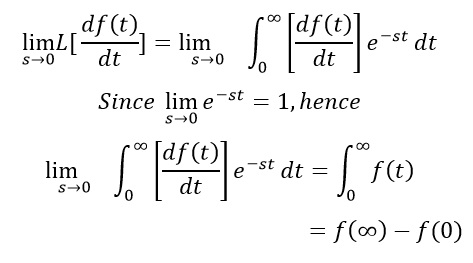Final Value Theorem is used for determining the final value of a Laplace domain function F(s). Though we can always transform a time domain function into Laplace domain to apply Final Value Theorem. According to Final Value Theorem, final value of a function i.e. value of function f(t) when t→∞ is given as,
In earlier post we already discussed about Initial Value Theorem and many important points which needs attention. We discussed, why Laplace variable s→∞ when t→0 for Initial Value Theorem.
So in this post we will not focus on those points but you can always refer earlier post on Initial Value Theorem to refresh. Let us now proceed to proof this theorem.
Proof of Final Value Theorem:
(You may think why did I took limit (s→0), why not limit (s→∞). You are suggested to read Initial Value Theorem to clear this doubt. If still you face problem, please write in comment box.)
But as per the definition of Laplace Transformation,
Since the function exists only for t≥0, hence f(0) = f(0+). Also f(0) is a constant, hence it can be taken out of the limit bracket. Hence,
Application:
Let us consider some examples to better understand the application of Final Value Theorem.
Example-1:
Find the steady state value of function given below
F(s) = 1/s(s+2)(s+5)
Solution:
Steady value of function means the final value. Hence for the above example, we will calculate final value.
Since, F(s) = 1/s(s+2)(s+5)
So, sF(s) = 1/(s+2)(s+5)
Using Final Value Theorem,
Example-2:
Find the steady state and transient state gain of wash out circuit. A wash out circuit is defined by the following transfer function.
F(s) = sT / (1+sT) where T is system time constant.
Solution:
Steady state gain can be found by applying Final Value Theorem whereas Transient state gain can be found out by using Initial Value Theorem.
Thus the steady state gain and transient state gain of Wash Out circuit is 0 and 1 respectively. This means that Wash Out circuit will only be active during transient condition. It will not do anything during steady state of system. Such circuits are widely used in control system. Hope you understood wash out circuit too.
Example-3:
Final the steady state and transient state gain of a unit step function.
Solution:
A unit step function is defined by the following transfer function.
F(s) = 1 / (1+sT), where T is system time constant.
Using Final Value Theorem,
Thus steady state gain of unit step function is unity while its transient state gain is zero.


F(s) = 1 / (1+sT), where T is system time constant.
Steady State Gain = lim [1 / (1+sT)]
s→0
= 1
Using Initial Value Theorem,
Transient State Gain = lim [1 / (1+sT)]
s→∞
= 0
In IVT LT s(f(s))? Why u used directly f(s)
S-infinity